All Things Digital conference hosted by the Wall Street Journal and technology columnists Walter Mossberg and Kara Swisher. My first hand observations of interviews with Steve Jobs (Apple), Julius Genachowski (FCC), Paul Jacobs (Qualcomm), Mark Zuckerberg (Facebook), James Cameron (Avatar), Steve Ballmer & Ray Ozzie (Microsoft), and Alan Mullaly (Ford). Demos of the Kno from kno.com and the Dell Streak youtube.com. All my photos available at flickr.com. In Chit Chat Across the Pond Bart tells us how to protect ourselves from tab nabbing attacks and continues his lessons on how to move from automatic to manual on your SLR – this week on light metering.
 Listen to the Podcast Once (1hr 19 min)
Listen to the Podcast Once (1hr 19 min)
Today is Sunday June 6th, 2010 and this is show number 263.
This week was the All Things Digital conference hosted by the Wall Street Journal and technology columnists Walter Mossberg and Kara Swisher. This was the 8th conference, dubbed D8, and my fifth time attending. If you haven’t heard me talk about it before, it’s a three day conference where Walt and Kara sit on stage with the CEOs of the top tech and media companies in the world. The attendee list is equally impressive – the opportunity to have one on one conversations with huge people in the industry over lunch or a drink is one of the biggest benefits of the conference. I’ll try to give you what I felt were the high points of each of the sessions without gushing too much.
Steve Jobs
Opening night was Steve Jobs, CEO of Apple Computers. You know I’m an Apple fanboy, so after he spoke I asked many people was he really as great as I thought he was, or was it the reality distortion field? Every person I asked said that they thought he really was fantastic. Martha Stewart is a technologist interestingly enough, and she told me she thought his answers were all very thoughtful and honest, and showed the great leadership of the man. Ok, good enough for me, here’s what I learned.
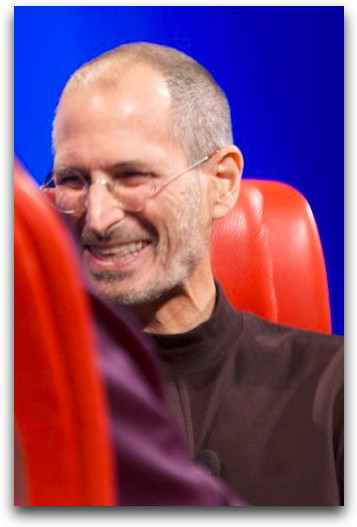 A major topic of discussion was the Flash issue and Jobs open letter about it. Walt said that even if all of what Steve said about Flash was true, is it really the best thing for consumers to be abrupt and cut off? Steve explained that Apple doesn’t have a lot of resources, so they have to choose what to chase, and if you choose widely you can do great. He walked through several of the technologies that Apple has abruptly cut off – they got rid of the 5″ floppy and switched to 3.5, then later they got rid of the 3.5″ floppy long before anyone else. They got rid of serial and parallel ports. They even got rid of the optical drive with the MacBook Air. He pointed out that people call them crazy – but how did all that turn out? I remember when the 3.5″ floppy was removed, we all raced out and bought external floppy drives, and never used them.
A major topic of discussion was the Flash issue and Jobs open letter about it. Walt said that even if all of what Steve said about Flash was true, is it really the best thing for consumers to be abrupt and cut off? Steve explained that Apple doesn’t have a lot of resources, so they have to choose what to chase, and if you choose widely you can do great. He walked through several of the technologies that Apple has abruptly cut off – they got rid of the 5″ floppy and switched to 3.5, then later they got rid of the 3.5″ floppy long before anyone else. They got rid of serial and parallel ports. They even got rid of the optical drive with the MacBook Air. He pointed out that people call them crazy – but how did all that turn out? I remember when the 3.5″ floppy was removed, we all raced out and bought external floppy drives, and never used them.
He pointed out that there are some holes in the internet now if you use an iPhone or an iPad, but he also pointed out that those holes are getting filled pretty rapidly. Walt asked whether this move is fair to developers, and Steve brought up the fact that they axed Hypercard and it was even bigger than Flash. Hmmm…wonder if anyone has researched that claim to see if it’s true? Steve explained that they told Adobe that they WOULD use Flash if it ran well, and it wasn’t until the iPad came out that Adobe started the big stink about it not supporting Flash (even though the iPhone didn’t either). Adobe put up that big stink in the press, and we just got tired of it, that’s why we had to publish the letter explaining our view. Walt expressed concerns about sites like Picnik which is a great site that allows you to edit photos online. Steve said that we have courage and focus on technologies that are in their ascendancy. At this point he said perhaps the most telling statement – “If we succeed in making great products, you buy them. If we don’t, you don’t buy them.” It was such a simple statement but really rang true, especially when he pointed out that they’ve been selling one iPad every three seconds, and he just wished they could build them faster than every 3 seconds.
When questioned about the stolen iPhone and the whole Gizmodo issue, Steve said a few things I found interesting. He said that they don’t know if their employee actually lost it or if it was actually stolen from his bag. That might explain why the guy still has a job, giving him the benefit of the doubt on that. He also explained how the police got involved. He said that the “reporter” plugged the stolen iPhone into his roommates computer to try and activate it, and when she realized what was going on, she called the police to make sure she wasn’t implicated. Steve described the entire scenario as sounding like a movie with intrigue and theft and betrayal – he said he was pretty sure there was sex involved in there somewhere too!
He said that a lot of people advised him to let the whole Gizmodo issue blow over, to let it slide. He did some real soul searching on that but said that in the end he realized that just because they’re becoming big and influential doesn’t mean they should abandon their core values and so it was wrong to just let it slide. I know Steve is a practiced speaker, but this was one of those points where it really looked like his statements came from the heart.
One of the classic things people say about Apple is if Steve denies a product is in the works, then you can put money on them doing it. He said no one would ever want to watch video on a small screen, he said they’d never have an app store, and on Tuesday night when asked why they acquired the search company Siri, he said they’re not a search company, they’re in Artificial Intelligence, and that Apple has no plans to go into the search business. does this mean we can bank on Apple going into the search business?
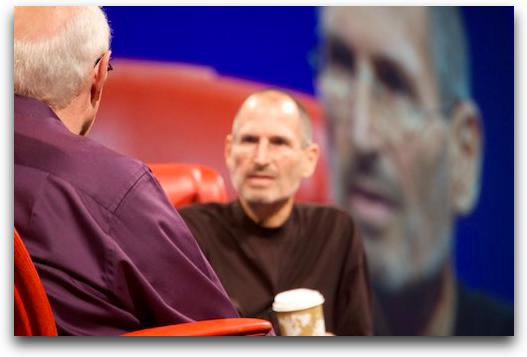 Walt asked Steve whether the iPad is the hope of journalism. Steve said that they have a lot of goals with the tablet and that any democracy depends on a free, democratic press with editorial and news gathering. He doesn’t want to see us descend into a nation of bloggers. Any way Apple can help with that and he’s happy. He pointed out that all of our news has moved to the web, and that we have to figure out how to get real reporters paid for this hard-earned content. He said that as one of the largest sellers of content on the web, Apple priced the content aggressively and makes their money in volume. He’s trying to get these content companies to be more aggressive as they don’t have any printing costs and make their money in volume.
Walt asked Steve whether the iPad is the hope of journalism. Steve said that they have a lot of goals with the tablet and that any democracy depends on a free, democratic press with editorial and news gathering. He doesn’t want to see us descend into a nation of bloggers. Any way Apple can help with that and he’s happy. He pointed out that all of our news has moved to the web, and that we have to figure out how to get real reporters paid for this hard-earned content. He said that as one of the largest sellers of content on the web, Apple priced the content aggressively and makes their money in volume. He’s trying to get these content companies to be more aggressive as they don’t have any printing costs and make their money in volume.
I have several comments to add in here. One of my pet peeves is bloggers and podcasters who call themselves journalists. To me a journalist is someone who researches, calls the sources directly, flies to Afghanistan and experiences what’s happening first hand or at least talks directly to warfighters to understand. Today people read what real journalists wrote, or watch videos of someone else’s work, then write or talk about it and call themselves journalists. Leo LaPorte, who I listen to constantly, makes this mistake himself. he has repeatedly called himself a journalist, but today he’s on the air so much it’s very rare that he ever hears anything first hand himself. He has opinions and analysis, and I frequently find his opinions very valuable and insightful, but he doesn’t have first hand knowledge in a lot of cases where he pontificates. I’m not sure I’d call myself a journalist but if you listen or read carefully, you’ll notice that it’s rare that I’m quoting someone else’s experience, when I review something it’s because I have personally touched it and worked with it.
The second comment I’d like to make is that Steve is spot on about the media companies lowering prices to compensate for the lack of printing. I believe I did a long rant about this with eBooks, how they should chop off the cost of printing, binding, boxing, shipping and sitting on store shelves, and take the same dollar profit but increase their percentage profit enormously. Ok, back to Steve.
Steve used an analogy to explain where he sees traditional PC’s going. He said that when we were an agrarian nation, all cars were trucks. When we moved into the urban environment, we started to change the car into sedans. PCs are going to be the trucks. We still need trucks, but the car is changing. Walt made sure that when he said PCs he included Macs as personal computers. Steve said he does include all laptops and desktops. He said it will make people from the PC world very uncomfortable, vested intents are going to change in the next 1, 3 to 7 years.
Steve spoke about his term “magical” for the iPad, said people laugh at him for it, but he said there is something magical about it. He said you have a much more intimate relationship with it than other devices. Some intermediate thing has been removed, as though you’re in that Claritin commercial when the film is removed. He asked if it’s the cables being removed? is it the touch? is it the 10 hour battery life? I caught myself the other day trying to explain this myself and I said “I can’t put my finger on it.” Maybe that’s the magical part.
Walt brought up that many people say the iPad is not a content creation device, and Steve said that if he wants to write a 35 page analyst report, he’d want a Bluetooth keyboard, but that’s only 1% of the time he’s using it. He said that the software will get better – he can see us editing video and doing all kinds of things on it. I enjoyed the conversation because I wrote 11 pages of notes using the iPad at D8 using just the onscreen keyboard. I’ll talk through that experience on next week’s show.
Walt pushed Steve to talk about the black box operation of the App Store. While any merchant has the right to not carry anything they don’t want to carry, is there a downside to him acquiring all of this power? Steve answered by explaining that there’s html5, css, and javascript that are all open, and that Apple has the best support of this completely open platform of the web. They also operate a controlled, curated platform. They insist on public APIs for stability. He gave an interesting statistic, he said that they approve 95% of apps submitted within 7 days. He talked about the mistake where a political satirist’s cartoons got caught up in the App Store rule that you’re not allowed to defame anyone. He gave insight here that I hadn’t heard before. he said the guy submitted the app, it got rejected, they figured out the mistake and fixed the algorithm. Later the guy was queried by the press and when he said it had been rejected, they jumped on it and made a huge deal out of it – but that the satirist himself was very professional and hadn’t raised a big stink, and hadn’t resubmitted after we fixed it. Steve was humble at this point and said that Apple is guilty of making mistakes, that no one has ever done this before, that they’re learning as fast as we can and fixing things as fast as they can. I have trouble finding fault with him here, but I know others (Bart) will still disagree with his approach.
Another close encounter with how Steve thinks came when Walt asked him what he does all day. Steve said that he has the best job in the world. He gets to hang out with the smartest best people making cool stuff. Apple is an incredibly collaborative company that has zero committees. One person is in charge of each thing, just like a startup. They all meet for 3 hours once a week and take about everything we’re doing, and you have to trust everyone to do their part. Walt asked him whether people tell him he’s wrong and he swore that they do. He said that they have wonderful arguments and the only way you can have great people working for him, the best ideas might win. I hope this is true, but it sure does sound hard to believe from picture we all have in our heads of what it’s like to work for him. I worked for a vice president once who said, “I refuse to be surrounded by yes men, because if that were the case, the best idea we’d have would be mine, and we can do better than that!” I really took that statement to heart.
The high point for me was when they opened the mic for questions to Steve. As you may recall, I’ve been practicing a question for about 3 weeks in hopes of this very moment. Well, I got to ask my question and it turned out to have a much more important effect than I thought. Asking a question at D is tricky because you have to be crisp about it or Walt gets agitated and gives you the hurry up signal. Here’s what I asked.
I bought the movie UP on Blueray with digital download for my portable devices. I
I bought the VGA adapter. But because of copyright protection I can’t play it on my projector. If I’d stolen UP by bit torrenting or reversing copy protection, I would have been able to play it. Can you explain how HDCP helps in the fight against piracy?
Steve listened carefully and said that movie companies are worried they’ll go through the Napster situation. He said that they aren’t in the security business so they’re grabbing at straws. Sometimes they grab the right straw, and sometimes they grab the wrong one. He said that Apple pressures them as much as they can, but if they insist, Apple only has two choices. Then he told me that he feels my pain. I asked him if he’d please point out the irony of the straw they’ve chosen.
The crowd reaction was great – they not only applauded the question, every person I talked to for the rest of the week said, “Hey, you asked a GREAT question!” It was so fun to be rewarded for how much I practiced that one. A lovely gentleman named Lee Stein spoke to me at length about my question and how articulate it was – I was preening like a peacock during that! There’ll pretty much be no living with me now, especially since even Martha Stewart told me I asked a great question. One person even told me that my question was on part with Martha’s hilarious question to Sir Howard Stringer of Sony about why they make us buy so many different chargers for our devices. now that’s high praise! I got a chance to hang out with Stewart Alsop, technology columnist I loved to read in Fortune Magazine. I kidded around with him about how he’s my Facebook friend (last year he told me he asks all beautiful women to be his Facebook friends), and he made a point of also telling me how grand my question was. Remember this story – it comes up again later.
Scroll to 1hr 26 min in to see my question to Steve (or watch the whole interview!)
Intermission
Now down’t worry, I won’t spend as much time on all the other speakers as I did on Steve, in fact I’m going to skip over a lot of them and only talk to the things I thought were really interesting. One thing that was interesting is that just about every CEO mentioned the iPad and how they’re using it. In the room probably 60% of the people were using iPads, and it started to look odd when you’d see someone with an actual laptop. When Julius Genachowski, the Federal Communications Commission chairman was on stage, Walt asked him if the president had one and he said that if he doesn’t he’s sure someone’s working on it for him.
ScreenSteps
While we’re taking a breather, let’s chat about ScreenSteps, shall we? If you’ve been sitting on the fence about buying ScreenSteps, it might help you to see it in action. Over at ScreenSteps.com they have some great articles on how to improve your software documentation to benefit your customers. I put a link in the shownotes to the articles, and if you’re more of the “please spoon feed me” type like I am, there’s webinars on how to use the right tool at the right time – when to use video, when to use screencasts and when to use still images. Even if you don’t buy ScreenSteps I’m betting you’ll learn something about how to help your customers. Assuming you’re smarter than that though and you DO buy ScreenSteps Desktop don’t forget the coupon code NOSILLA to get 25% off the purchase price.
Demo – Kno Tablet
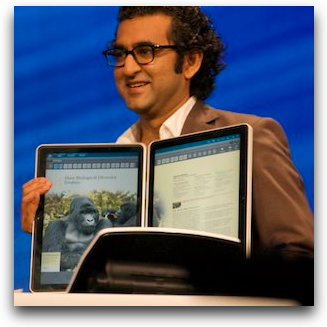
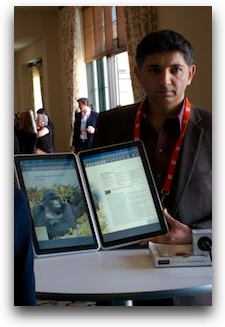 Speaking of tablets, Walt and Kara invited the folks from kno.com to demonstrate their new tablet concept. It was pretty clear to me that the hosts were trying to find anyone with any other interesting tablet story to try and have a more balanced view of things than all iPad all the time, but with HP out of the game until they figure out how to adapt WebOS to the tablet, and with Microsoft completely out of the game for now, they had to dig deep. They were super polite to these guys but I had a lot of problems with the device. The Kno is aimed straight at the student market, to replace everything that’s in today’s back packs from books to notebooks to pens to sticky notes. Unfortunately they had to misrepresent a lot of facts to make their comparison go well. They said that a typical student backpack is around 20 pounds (my kids were in the 40 pound range, but they were over achievers so perhaps that accounts for the difference.
Speaking of tablets, Walt and Kara invited the folks from kno.com to demonstrate their new tablet concept. It was pretty clear to me that the hosts were trying to find anyone with any other interesting tablet story to try and have a more balanced view of things than all iPad all the time, but with HP out of the game until they figure out how to adapt WebOS to the tablet, and with Microsoft completely out of the game for now, they had to dig deep. They were super polite to these guys but I had a lot of problems with the device. The Kno is aimed straight at the student market, to replace everything that’s in today’s back packs from books to notebooks to pens to sticky notes. Unfortunately they had to misrepresent a lot of facts to make their comparison go well. They said that a typical student backpack is around 20 pounds (my kids were in the 40 pound range, but they were over achievers so perhaps that accounts for the difference.
They also said the typical student laptop is 15-17 inches and weighs 7 pounds. Um, no? I would put it closer to 13-15 inch and no more than 5 pounds. But that wouldn’t help their story. So let’s talk about what the Kno is. It’s two 14 inch screens, connected together by a flexible seatbelt fabric hinge that allows them to flip so they’re closed facing each other, all the way around to them facing apart. The Kno weighs 5.5 pounds which is surprisingly light for how huge this this was. They didn’t say how thick it was but I’d estimate that each screen was at least 3/4ths of an inch thick.
Enough about dimensions, the Kno is designed to have beautiful displays (the guy said it so many times Walt started teasing him about it) that show off rich textbooks with graphics. It will have Wifi, but no 3G because most campuses are covered with wifi which does seem to be true. It will support office formats, PDFs, will have a virtual keyboard and support Bluetooth keyboards as well. The operating system is Linux with Webkit (that’s the browser technology under Safari and Chrome) and will support flash. They quoted 6-8 hours of battery life with a price tag of “under $1000”.
I really liked these guys but it’s WAY too big, it’s got to be impossible to hold with no support holding those two giant displays at an angle to each other, it’s way too heavy and that’s way too expensive. They did say they have deals with 4 education book companies which represents about 75% of all book companies but I can’t imagine this being a device a student would want. You can take a look for yourself over at kno.com
Julius Genachowski – FCC chairman
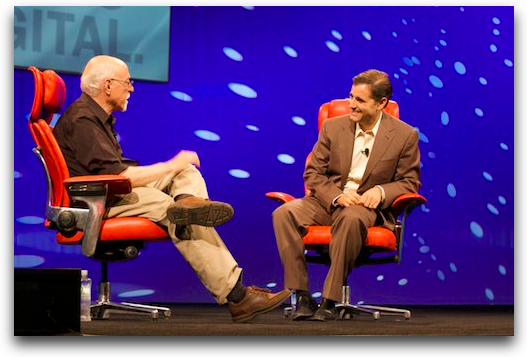 FCC chairman Julius Genachowski was pretty interesting, but Walt was brutal with him. It’s interesting to watch who Walt is gentle with and who he gives more respect. Basically Walt asked him why hasn’t he fixed everything yet? He pointed out that Genachowski isn’t from the telco’s but still we’re lagging the world in broadband. Genachowski pointed out that out of 40 countries we were determined to be 6th out of 40 in broadband speeds, but that wasn’t the real concern. What really scared him was the finding that we’re 40th out of 40 in the rate of change of innovation. He didn’t explain how that was measured, but he called that the canary in the coal mine.
FCC chairman Julius Genachowski was pretty interesting, but Walt was brutal with him. It’s interesting to watch who Walt is gentle with and who he gives more respect. Basically Walt asked him why hasn’t he fixed everything yet? He pointed out that Genachowski isn’t from the telco’s but still we’re lagging the world in broadband. Genachowski pointed out that out of 40 countries we were determined to be 6th out of 40 in broadband speeds, but that wasn’t the real concern. What really scared him was the finding that we’re 40th out of 40 in the rate of change of innovation. He didn’t explain how that was measured, but he called that the canary in the coal mine.
Again Walt attacked with why don’t you fix this? Isn’t this your job? Genachowski said they spent the last year making the plan to fix this, to drive more competition giving us more options. He said that we have to take advantage of mobile so that’s why we’re the first country going to 4G. The demand on the networks ins’t going down, it’s going up at a rate that dwarfs the rate of increase of the status quo plan, so the status quo plan just isn’t going to get us where we need to go. He said to expect network congestion for a long time, and that we have to find better efficiencies. I would have liked to hear some details of the plan, and maybe a timetable of implementation of the plan but he didn’t touch on any of those icky little details.
Walt kept pushing and tried to get Genachowski to discuss consequences from the FCC when a provider doesn’t deliver what the user is playing for – like making phone calls on their iPhone. Instead of even addressing the question, Genachowski started talking about how confused consumers are about what speeds they’re getting or should expect on broadband. Oh well, I sure hope that plan he’s got is good and implementable in our lifetimes.
Paul Jacobs – CEO Qualcomm
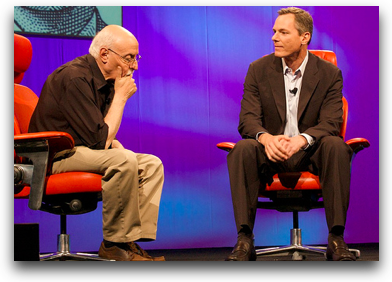 One of my favorite speakers was the CEO of Qualcomm, Paul Jacobs. I liked him because he’s an engineer and that threw Kara for a loop. Seriously it’s not that she’s not technical, it’s that he came right out spouting specs and acronyms. Luckily she did slow him down because he said one thing that really confused me and she made him back up. He was talking about how Qualcomm’s technology is in every smart phone out there. Kara said well wait a second – you make CDMA phones and the iPhone is a GSM phone, so how are you in that? Jacobs explained that GSM phones still use CDMA for their 3G data. I did not know that.
One of my favorite speakers was the CEO of Qualcomm, Paul Jacobs. I liked him because he’s an engineer and that threw Kara for a loop. Seriously it’s not that she’s not technical, it’s that he came right out spouting specs and acronyms. Luckily she did slow him down because he said one thing that really confused me and she made him back up. He was talking about how Qualcomm’s technology is in every smart phone out there. Kara said well wait a second – you make CDMA phones and the iPhone is a GSM phone, so how are you in that? Jacobs explained that GSM phones still use CDMA for their 3G data. I did not know that.
The most important thing Jacobs talked about was a new display technology they’re working on called mirasol. The trick of this technology is that it’s reflective the way a butterfly’s wings are reflective, so when you reflect light off of it, specific wavelengths interfere with each other to create color. The underlying technology is dependent on the use of MEMS Mirrors. MEMS stands for microelectromechanical systems. The MEMS in mirasol are actually tiny mirrors going up and down inside each pixel, as they change distance from each other they create a different color.
Ok, but what does that all mean to us? It means lower power consumption, aka longer battery life. He said it was 10 to 100 times more energy efficient than an LCD depending on the lighting conditions. It also gives you brighter displays in broad daylight. So they can light it up indoors for you with low power and it still looks good outside, AND it’s color. Sounds like the best of both worlds between eInk and LED/LCD displays. The even better news is that they already have a fab shop making these, and they expect to have up to 5.7 inch displays as early as next year. They’ll be starting with eReaders, but there’s no reason this can’t be in touch screen displays as well with a sheet of glass on top of it. I’m excited about this because it’s really smart people working on the number one problem – battery life!
Qualcomm had a booth in the Science Fair, and Dan Baker was there showing off the new Dell Streak at their booth. Qualcomm was displaying the Streak (along with other devices) because it sports their SnapDragon processor. I made a quick video of the Streak during my interview and I’ve embedded it in the shownotes. The Streak is an Android smartphone, but it’s distinction is that it has a massive 5 inch display. There are those who have suggested that this is too big to be a smartphone and too small to be a tablet and is therefore useless. I hate it when people do that who haven’t actually touched the device! The screen is huge on this device but it doesn’t feel huge because it’s very thin and is nicely rounded on the edges. As I say in the video, it’s very “holdable” – it feels good. The screen was very responsive and bright. In the 2 minutes I got to play with it I couldn’t say it was something I would buy but it’s definitely worth consideration.
The Qualcomm Snapdragon process is worth consideration too – they have a 1.5GHz version coming out soon and they also just announced a dual core 1.2Ghz processor for phones.
Mark Zuckerberg – CEO Facebook
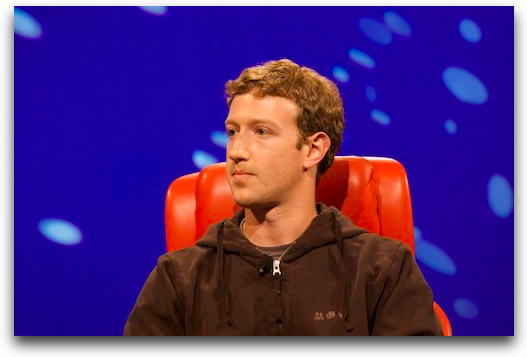 And now it’s time for the train wreck that was Mark Zuckerberg, CEO of Facebook. I was shocked that he would agree to come to D, with all of the hubbub about the privacy settings in Facebook, but at least he had the courage to be there. That’s about the only good thing about the interview.
And now it’s time for the train wreck that was Mark Zuckerberg, CEO of Facebook. I was shocked that he would agree to come to D, with all of the hubbub about the privacy settings in Facebook, but at least he had the courage to be there. That’s about the only good thing about the interview.
Walt dug right in at the beginning asking him why he thought it was ok to change our privacy settings on us. Mark said that there are misperceptions, and that people need to bea ble to find you, they need some information to figure out if you’re the one they’re looking for. People have the misconception that we tried to make everything public. Sensitive things like your contact info and photos are not made public. EXCUSE ME? He’s either a) a liar, or b) completely out of touch with what his company is doing. Last week before the new and improved privacy settings were put up, I checked and 100% of my photos were now set to Everyone as having access. I never ever ever ever EVER chose that. I didn’t even allow friends of friends, much less Everyone. I believe he’s too technically smart to not know what his algorithm did, so I must presume he’s simply lying at this point.
When Zuckerberg said that they changed some things and always asked people to review them, Walt asked why do I have to go to the work of fixing what you’re changing? Zuckerberg’s only answer was “Simple control has always been part of Facebook.” Ok, now I have to back off of the liar statement and move to delusional.
Walt moved in for the third time asking why Zuckerberg thought he had the right to make our information public but before he could do another non-answer, Kara broke in and started asking him questions about his personal life. At the time I couldn’t imagine why she did this but it became apparent later. At this point Zuckerberg started to babble. He was talking and saying sentences that had nothing to do with the conversation. and then he started to sweat. I don’t mean a light beading on the forehead, I mean rivulets of sweat pouring down the sides of his face. Even though it was actually uncomfortably cold in the audience, I know the lights can get extremely hot, but you couldn’t watch this complete mental and physical breakdown without thinking of Nixon in the 1960 presidential debate against Kennedy.
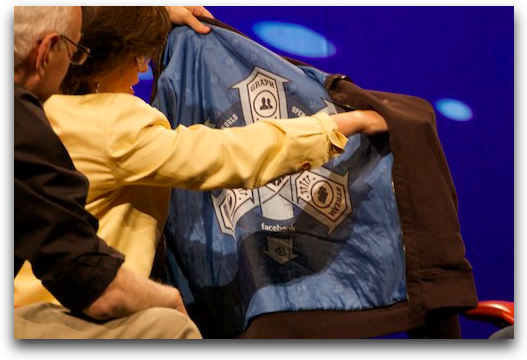 Around this time, Kara and Walt started to treat him gently like a young child that needed to be cared for. Kara suggested that he take off his hoodie (which just sounds wrong that a CEO of a squillion dollar company would be wearing a hoodie to arguably one of the most important interviews of his life), but he said, “but I never take off my signature hoodie.” The man is literally melting on stage and he thinks this “look” is important. Finally he acquiesces and Kara actually has to help him with the jacket. When she pulled his jacket off, he mentioned that their company vision is actually printed on the inside of the jacket. It was kind of scary actually – someone tweeted the perfect description – it looked like the Dharma Initiative logo!
Around this time, Kara and Walt started to treat him gently like a young child that needed to be cared for. Kara suggested that he take off his hoodie (which just sounds wrong that a CEO of a squillion dollar company would be wearing a hoodie to arguably one of the most important interviews of his life), but he said, “but I never take off my signature hoodie.” The man is literally melting on stage and he thinks this “look” is important. Finally he acquiesces and Kara actually has to help him with the jacket. When she pulled his jacket off, he mentioned that their company vision is actually printed on the inside of the jacket. It was kind of scary actually – someone tweeted the perfect description – it looked like the Dharma Initiative logo!
Ok, Mark has wiped the buckets of sweat off his face, he’s had a moment of fun with his hoodie, so Walt asks him a fourth time whether sharing information shouldn’t be opt in. He doesn’t think so – he said it would be crazy to make people opt into everything – like when the created the News Feed in Facebook, it wouldn’t make sense to make people opt in. He assured us that as you begin to use these applications you’ll have a good experience and start to feel good about them. Sorry Mark, I’m not having a good feeling about you sharing my personal photos with the internet. I would have put them on Flickr if I wanted them shared with the world.
So I was talking to a producer during a break the next day (wish I could remember her name) and we were talking about the disastrous Zuckerberg interview and I mentioned that I was surprised that Kara and Walt didn’t go in for the kill when Zuckerberg started to fall apart. I thought it was an obvious move to rip him to shreds. She said that if they had done that, they’d have looked like bad guys. Instead by treating him like the poor child that he is, so very far out of his league, helping him with his jacket and being so gentle with him, they looked like nice people and his incompetence was magnified. I have to say, if I wasn’t worried about my privacy on Facebook before, I’m terrified now. So everyone – where are we going next? I’m ready to go but I want to go where everyone else goes!
One last thought on privacy before we move on, someone at one of the breaks explained the lack of interest in privacy. he said it’s like trying to connect smoking and cancer, the problem is so far away from the event that it’s hard to picture what could possibly go wrong. I thought that was a pretty good analogy.
James Cameron – Writer, Director, Producer
Let’s cleanse our palettes now with a great interview. Steve Jobs was still probably my favorite, but a very close second was the interview with James Cameron, Writer, Director, Producer, most recently known for his films Avatar and Titanic. He was positively riveting. Walt asked a lot of questions about 3D – how necessary is it to the movie Avatar for example. James said that 98% of his job was not about the 3D-ness, it was the actors, the colors, the plants. 3D doesn’t fundamentally change the story telling. He noted that the 2D version of the DVD sold very well, and they weren’t sure that would happen so it showed that the story telling is what’s really important. He says the movie scales from the iPhone to IMAX.
Walt asked what movies wouldn’t you make in 3D and James said something like Schindler’s list – made in black and white on purpose. 3D would ruin that film. On the other hand, he announced that they’re remastering Titanic in 3D for the 100th anniversary of the event in 2012. That movie was frightening enough for me (I hate sunken or sinking ships – gives me the willies as a sailor) can you imagine as the ship turns vertical and the people are falling from it how awful that would be?
At this point the interview took a tangent to something very important – the work James Cameron is doing to try and assist with the British Petroleum oil leak. As he was watching the growing horror in the gulf, he realized that he knows a lot of brilliant people in deep submergence who understand the engineering required in deeper depths. He approached BP first and they were very gracious, but they said, “we’ve got it”.
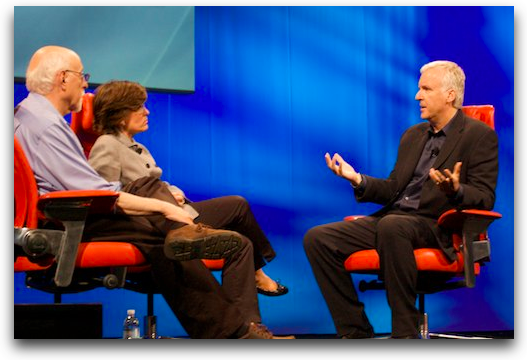 So he pulled 23 people together at the EPA headquarters to discuss solutions. They were given the facilities and the video teleconferencing so they could pull in experts from around the world to work the issue but they weren’t officially sanctioned by any of the government entities. He talked about how the effective pressures they’re working under are equivalent to 18,000 feet and that steel bends like butter under that pressure. He said this is not a plumbing problem and noted that if they make a mistake, they could blow this out and have it blow in 30 places at once becoming even more catastrophic than it already is. He felt it was very important that the government get this independent source, or it’s like asking the criminal to provide crime scene tapes. I could have listened to James talk about this for hours, but they wound up that part of the discussion with the fact that they’re submitting a paper to all of the government agencies – but no details on their recommendations.
So he pulled 23 people together at the EPA headquarters to discuss solutions. They were given the facilities and the video teleconferencing so they could pull in experts from around the world to work the issue but they weren’t officially sanctioned by any of the government entities. He talked about how the effective pressures they’re working under are equivalent to 18,000 feet and that steel bends like butter under that pressure. He said this is not a plumbing problem and noted that if they make a mistake, they could blow this out and have it blow in 30 places at once becoming even more catastrophic than it already is. He felt it was very important that the government get this independent source, or it’s like asking the criminal to provide crime scene tapes. I could have listened to James talk about this for hours, but they wound up that part of the discussion with the fact that they’re submitting a paper to all of the government agencies – but no details on their recommendations.
Walt asked James then about making his films available to people who want to watch on the small screen and yet not steal it. That’s the only time I thought James was off base – he said if you take away the 2% of the population who have qualms about stealing and are under 30 you’re left with 98% who will still steal. I don’t think I agree with him here, and I think there’s evidence that when iTunes came along and made it easy and convenient to pay for music at a reasonable price, people rushed to it in droves!
One part I liked was when he was talking about how certain movies are better for certain formats – he said I’d never watch 2001 on a laptop screen, but Hangover is just as funny on a laptop as it is on a big screen. Hangover is hilarious, keep meaning to buy that one for future rewatching! He also said he wouldn’t watch a movie on an iPhone but he would watch on an iPad. Then he had one of my favorite quotes, he said “I guess if its too small you’re too old.” Tru dat, Mr. Cameron.
When it came time for Q&A I told him that my dad always said there are no dumb question but that I was pretty sure my question was really dumb. I asked him to explain how his film was 3D, but it was Computer Graphics or CG. which was it – was it filmed, or was it computer graphics? He was very gracious and didn’t tell me I was dumb at all. I’m still not sure I completely understand the answer but he said the movie was about 65% CG, but even that was “shot” with a virtual camera that they carried around and sometimes the actors were in suits with facial things on. That was the last 2.5 years of R&D. I guess it makes sense that I didn’t understand.
Right after my question, Stewart Alsop is up next, and he takes the mic and says “Ok Allison, you’re still my Facebook friend, but you just stole my question!” I loved it.
Microsoft CEO Steve Ballmer & Chief Software Architect Ray Ozzie
 Walt and Kara had an interesting duo on stage with Microsoft CEO Steve Ballmer & Chief Software Architect Ray Ozzie. Ballmer was very bullish on the market due to Windows 7 and noted that even the business market is finally beginning to spend. Walt asked them to elaborate on their strategy for the cloud, and Ray Ozzie fielded that question. I’m not sure I understood his answer though, he talked about standards-based ways to write applications and that his mission is to get the developers in Microsoft to stop thinking about the PC as the objective and think about user productivity as the objective. He went on to say that this is the opportunity for us to “repivot” to the cloud for centralized work using different screens – online and offline. Repivot? What the heck does that mean?
Walt and Kara had an interesting duo on stage with Microsoft CEO Steve Ballmer & Chief Software Architect Ray Ozzie. Ballmer was very bullish on the market due to Windows 7 and noted that even the business market is finally beginning to spend. Walt asked them to elaborate on their strategy for the cloud, and Ray Ozzie fielded that question. I’m not sure I understood his answer though, he talked about standards-based ways to write applications and that his mission is to get the developers in Microsoft to stop thinking about the PC as the objective and think about user productivity as the objective. He went on to say that this is the opportunity for us to “repivot” to the cloud for centralized work using different screens – online and offline. Repivot? What the heck does that mean?
Ballmer jumped in and said that you’re still going to keep a lot of storage and processing on the client, and that the key is how you feed that to the server. Walt asked if that means this is not the opportunity to create cheap, dumb devices? Ballmer explained that you’ll have cheaper devices but you still need reasonable amounts of processing and graphics. Ray sort of contradicted Ballmer then, saying that people just want appliances, buy it, log in, and light it up and that applications will feel more like caches. It was interesting to me that they sat side by side contradicting each other, makes me worry about how you have a consistent strategy when the top two most influential people have opposite opinions about where the technology is going.
Walt asked them who their competition is – what threats do they see. Ballmer of course was the cheer leader saying that they’re going from a world that was good for Microsoft to one that is great for Microsoft, but that they just have to out hustle everyone else. In terms of competition, he listed Oracle, Apple, VMWare, and in television both Nintendo and Sony. He actually sited Firefox and Linux as primary competition too. That’s a pretty important realization I think.
Walt brought up the fact that unprompted by him and Kara, many of the speakers had a lot to say about the iPad. Ballmer admitted to actually using the iPad – which I thought was interesting because if he’s smart he’d be playing/working with it. He did of course make a smart aleck comment about it – he said he tried to use the onscreen keyboard, THAT was fun.
Walt brought up Steve Jobs’ assertion that fewer people will be using PCs as we go forward (Macs and Windows) and asked Ballmer what he sees in the future. Shockingly Balmer said people will be using PCs more and more in greater numbers than ever before, but that they’ll get smaller, and have a keyboard or not, be media centers or touch UIs. He said the real question is, “what’s a PC?” He said that an iPad IS a PC, so he sort of redefined the subject in his own terms.
Walt brought up the fact that tablets haven’t worked before – will tablets of the future have Windows, look like Windows on his PC? Ballmer said that people want the familiar look of Windows. He said that Linux Netbooks didn’t sell well, and Walt said that it was because Microsoft lowered the price of XP to compete. Ballmer simply repeated his statement and said Linux netbooks didn’t sell well.
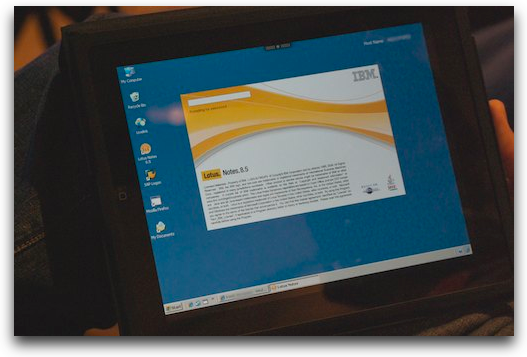 Ray Ozzie seemed to be more in touch with consumer needs – he pointed out that more people consume than produce, so the “pad” form factor is better for that. He said that Microsoft has to drive out complexity and that virtualization technologies will let us move to the future. He said that productivity and creativity is additive, you like to get the new features, but consumption is all about subtractive, removing complexity. I think he’s spot on with this.
Ray Ozzie seemed to be more in touch with consumer needs – he pointed out that more people consume than produce, so the “pad” form factor is better for that. He said that Microsoft has to drive out complexity and that virtualization technologies will let us move to the future. He said that productivity and creativity is additive, you like to get the new features, but consumption is all about subtractive, removing complexity. I think he’s spot on with this.
Speaking of virtualization and pads, one of the folks I was sitting next to at the show demonstrated how he can securely connect over VPN into his company’s network and use virtualization software to connect into a blade server running windows. I took a picture of it so you can see how weird seeing Microsoft Windows and Lotus Notes running on an Apple iPad using Cisco VPN software. Makes you think maybe we all CAN get along.
Back on the competition angle regarding mobile devices, Ballmer pointed out that RIM has 60-70% of their business in the consumer market which people miss, Nokia is close to zero in the US but their international business shows a world class supply chain. Apple has done the best job on the browser and that’s what’s distinguished them amongst their competitors and that they’ll be a good competitor. Google has a lot of momentum in phones with Android but on the larger screens, who knows – it’s a jump ball.
The one point where Ballmer seemed to get flustered was when Walt asked him about the Chrome OS from Google. I know he likes to jump around and act funny, but he did it on this question and it just looked sort of like flailing. He said that he doesn’t understand it – he yelled “what am I supposed to think about it?” Imitating the old commercial, he said it’s two, two, two things…but NOT in one. Luckily he brought Ray Ozzie with him who simplified it. He said that Android is a bet on the past as an operating system for phones, and that Chrome is a bet on the future – Chrome is all about devices working in the could. Ballmer insisted that it still makes no sense to him.
Alan Mullaly CEO Ford Motor Company
 As a Honda and Acura owner, it pains me to say that I was really impressed with Alan Mullaly, CEO of Ford Motor Company. He was so different than what you’d expect of an old auto company – he was dressed in a red sweater vest with a big Ford logo on it, and he spoke with candor, humor and excitement about where Ford is going. The first thing that impressed me was when he said that he drove a Toyota Camry into work one day at the Ford Corporate Headquarters. They almost didn’t let him in – everyone thought he was crazy! He explained to them that there’s no way to tell what their competition is doing unless they drive their cars, and he said right away everyone started testing out different cars. That kind of shift in attitude has to be good for Ford and for the American auto industry. If Steve Ballmer can use an iPad, the Alan Mullaly can drive a Camry.
As a Honda and Acura owner, it pains me to say that I was really impressed with Alan Mullaly, CEO of Ford Motor Company. He was so different than what you’d expect of an old auto company – he was dressed in a red sweater vest with a big Ford logo on it, and he spoke with candor, humor and excitement about where Ford is going. The first thing that impressed me was when he said that he drove a Toyota Camry into work one day at the Ford Corporate Headquarters. They almost didn’t let him in – everyone thought he was crazy! He explained to them that there’s no way to tell what their competition is doing unless they drive their cars, and he said right away everyone started testing out different cars. That kind of shift in attitude has to be good for Ford and for the American auto industry. If Steve Ballmer can use an iPad, the Alan Mullaly can drive a Camry.
Alan described watching a woman driving a car, with her hands through the steering wheel holding a cell phone behind the wheel so she could text with both hands. He decided at that point that their objective should be that when you buy a Ford you get the car with the newest tech that makes you a better driver. They’ve put voice, music and data all over bluetooth, and they can make phones read text messages to you out loud. They can’t do the reverse well enough yet, allowing you to text back using their voice but they’re working on it.
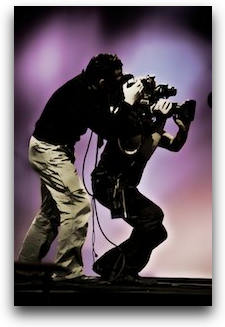 They’re goal is to have instrumentation that’s always right in front of you – so your hands are on the wheel, and your eyes are on the road. Walt said that on the lowest end Ford car you can buy (a Ford Fiesta) the interface to his iPhone and iPod was better than anything on a Mercedes. Alan was obviously pleased with that and also pointed out that it used to cost you $400 for that setup, but now it’s free on their cars for the first three years.
They’re goal is to have instrumentation that’s always right in front of you – so your hands are on the wheel, and your eyes are on the road. Walt said that on the lowest end Ford car you can buy (a Ford Fiesta) the interface to his iPhone and iPod was better than anything on a Mercedes. Alan was obviously pleased with that and also pointed out that it used to cost you $400 for that setup, but now it’s free on their cars for the first three years.
If I were in the market for a new car, and I was not such a rabid Honda/Acura fanatic, I would definitely consider a Ford after hearing Alan Mullaly speak.
Closing of D8
I know I skipped a lot of speakers but these were the ones who intrigued and excited me the most. I want to give a shoutout to the two gentleman who do the video and still photography for D – Robbie Lawrence and Asa Mathat. These two guys are scrambling all around the floor, up and down off stage, getting closeups and panning the audience and lying on the ground sometimes – I’ve never seen two people work so hard for three straight days in my life. I took a photo of them I’m rather proud of so I put that in the shownotes as well. And finally I put a link to all of the photos I took at D8 over at flickr.com.
Honda Bob
So you heard me talking about how great the Ford CEO was, but I really could never buy a Ford, and while part of that is because I love Hondas and Acuras, the main reason is because of Honda Bob! I’ve only had one mechanic in my ENTIRE driving life, so how could I possibly go out and find a second one now at this stage in my life? I couldn’t imagine going into the dark ages where you have to drive to them instead of them coming to you – so very barbaric! If you live in the LA or Orange County areas, and you own a Honda or Acura, give Honda Bob a call at (562)531-2321 or send him an email at [email protected]. HDA Bob’s Mobile Service is not affiliated with Honda, Acura or Honda Worldwide.
Chit Chat Across the Pond
Security Light
- Next Tuesday is Patch Tuesday – 3 critical patches, 7 important patches, ranging from Remote Code Execution to Privilege escalation, affection Windows, IE & Office –microsoft.com/technet/security
- Open Office users should be sure to update to version 3.2 to protect against a number of remote code execution flaws. –securityfocus.com
Security Medium – Tab Nabbing
How it works:
- The attack is based on JavaScript, with which it’s simple to do the following:
- First the JavaScript detects that the tab it is in has lost focus. Then it waits for a certain amount of time to be sure you really have given up on that tab.
- Then it changes the favicon to the one for the site it wants your login details for
- Then it replaces the content of the page with a fake login window for the site it’s attacking – and waits.
- The idea is that if you a million tabs open like most people do, you’ll forget what you had where. You’ll spot the favicon, think you’ve been timed out, and try to log in. BAM – they have your username and password!
- To make matters worse, they don’t even have to guess what sites to imitate, there is a JavaScript + CSS based attack for determining where you have browsed before.
How can you protect yourself?
- Only form of total protection would be to disable JavaScript totally – very un-practical
- Sufficiently skilled users could protect themselves by limiting their possible exposure using NoScript
- A simple solution is to ONLY use Site Specific browsers for sites that are sensitive, or likely to be attacked, e.g. Web-based email services, banking services, and social networking services like FaceBook or Twitter. Then if one of your tabs gets morphed in your main browser you should notice because that tab simply shouldn’t BE there.
- Get into the habit of checking the URL in the address bar for all sites that ask for a login always. This attack cannot change the URL of the tab to BE the attacked site!
- Thinking about it, browser manufacturers (or plugin makers) could defend against this by freezing the JavaScript running in all tabs that lose focus.
Main Topic – Taking Control of Your Camera – Continued
- We previously discussed getting from Automatic or Program modes to progressively more manual modes.
- Last time we limited ourselves to understanding how you can control the exposure triangle, ISO, Shutter & Aperture.
- Today we’ll look at 3 more controls you can take over.
- Before we start an very important reminder, half-pressing the shutter will trigger the autofocus and the metering. You can half-press then recompose and fully press to use the focus and exposure readings from the first place in the composed shot.
Taking control of the camera’s shooting mode:
- When you press the shutter, what should the camera do?
- The default is to simply take one exposure straight away – more than 9 times out of 10 this is what we want, but not always.
- For action scenes, or for shots where you’re at the edge of your ability to hand-hold, continuous fire/rapid fire modes are handy (the exact name may vary). In this mode the camera keeps shooting as long as you keep holding down the shutter. The limit to how long you can fire is the size of your camera’s buffer, and the speed of your memory card. The bigger the buffer and the faster your card the longer you can keep firing in this mode
- Another hand mode is a delayed exposure – here you would press the shutter and then the camera would fire a few seconds later – perfect for getting yourself into group shots.
- If your camera supports an IR remote you probably have to explicitly tell it to obey the remote in the shooting mode menu, and you may even have the choice of instant response remote or delayed remote. Delayed response remote is really perfect for getting yourself into a group shot – you don’t have to move, just take the few seconds to hide the remote!
Taking control of your camera’s Light Meter
- We talked a lot about how the camera uses a light meter to calculate the correct exposure of a scene. When you use Aperture priority it’s the meter that tells the camera what the matching exposure for your chosen Aperture should be etc..
- This light meter can work in a number of different modes, it will vary from camera to camera, but you’ll generally get at least these three options:
- 1 – matrix mode – the default – average the entire scene to the correct brightness (generally assumed to be 18% grey but there’s some argument about whether or not it’s actually 14%). This averaging really messes up in scenes with high dynamic range, getting nothing perfect at all. A good sensible default though, and you can use exposure compensation to express your desire on how the camera should deal with the scene.
- 2 – spot metering – a single spot reading is taken, usually at the very centre of the field of view, and that single spot is exposed to 18% grey – this is great if you want to take a reading from a grey card, but will generally not work on ordinary scenes.
- 3 – centre weighted metering – a half-way house. Does not use a spot, but a larger region in the centre of the frame. Priority is given to getting the central area properly exposed, perfect for dealing with very variable scenes, you choose where to meter, and that will be properly exposed.
Well I hope you guys are still here for the end of the show – that was a looooong one wasn’t it? You can’t believe how many stories I left out of the show, but I had to cut it off somewhere! I hope you’ll join us in the live chat room one of these days – it’s so much fun to chat with the NosillaCastaways and they keep me on my toes! Check it out at podfeet.com/live on Sunday nights 5pm Pacific time. In the mean time, keep up those dumb questions, comments, and suggestions by emailing me at [email protected], and don’t forget to follow me on Twitter at twitter.com/podfeet. Thanks for listening, and stay subscribed.

Super podcast. Question: Since the new security problem is called Tab Nabbing, I assume that it only happens (so far) in tabs and not in separate browser windows that might be out of sight and inactive? That is, is one safe if one does not use tabs?
Hi Jan,
To be honest, a browser window with one page is a browser window with one tab. The tabs have no idea whether they are one of 500 or 1 of 1, so I can’t see how it would make a difference. If a windows with just one page in it had this malicious JS in it and you then switched away to another app, it would lose focus and the attack would execute. You’d just be a lot more likely to notice, and hence a lot less likely to get burned.
Hope that helps,
Bart.